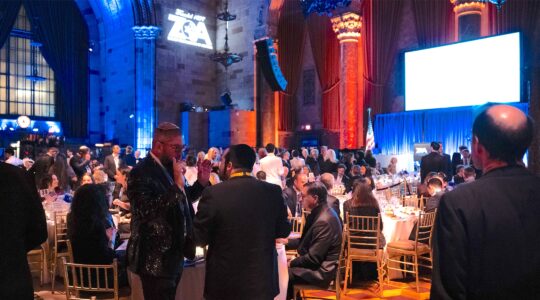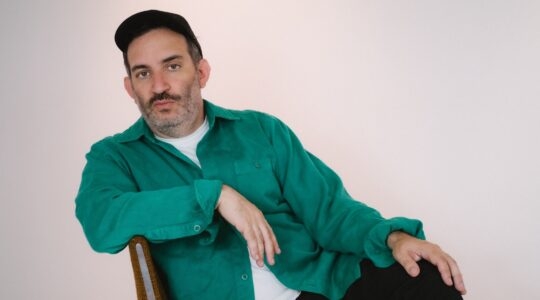Although he has been blind since 2007, David Toren of Manhattan said he can still see in his mind’s eye Max Liebermann’s oil painting “Two Riders on the Beach.”
In the lyrical painting, marked by bold brushstrokes that capture a swelling sea, two handsomely dressed horsemen walk their chestnut charges along the soft sand. It had hung on the wall of the sunroom in his great-uncle’s villa in Breslau, Germany, when he was growing up — the same room where his father, his great-uncle and guests played cards every few weeks.
He hasn’t seen it since 1938. In August 1939, Toren’s parents placed him on a train to Switzerland — one of the Kindertransports that carried Jewish children out of Nazi-occupied countries. He was 14.
Four months later, a Nazi official wrote a letter describing how the Third Reich had “secured” the artwork of Toren’s great-uncle, David Friedmann, a wealthy industrialist and landowner, and catalogued each piece. Among them were paintings by Jean-Francois Raffaelli and Henry Rousseau. Two paintings were mentioned by name: “Two Riders” and another Liebermann work, “Basket Weavers.”
Friedmann died of natural causes in 1942 and his villa in Breslau was sold at auction with the proceeds “forfeited to the Reich.” The Nazis murdered his only daughter, Charlotte, a year later.
Now, more than 70 years later, the painting, and Toren’s attempt to retrieve it, are part of the art world’s most tantalizing story. “Two Riders” was among a trove of suspected Nazi-looted artworks seized by Bavarian authorities in February 2012 from the home of a Munich art collector, Cornelius Gurlitt. In a lawsuit filed last month, Toren, with the help of his son, a lawyer, sued the German government and the Free State of Bavaria, seeking the return of “Two Riders.”
“I had never thought of the painting,” after the war, he told The Jewish Week. “I come from a place where we lost everything. My parents were killed in Auschwitz, and I had no expectations and no thoughts of it [the painting]. I had other problems.”
Toren eventually came to the United States, married and had a son, Peter, now 55; they both practice law. About six years ago, a law firm in Germany contacted him to say they were running down a lead about the whereabouts of “Two Riders”; it proved erroneous.
Last November, Toren learned that “Two Riders” had indeed survived the war — in the home of Cornelius Gurlitt. The seizure of Gurlitt’s trove — which included some 1,400 works of art by such masters as Claude Monet, Édouard Manet, Pablo Picasso and Auguste Rodin and valued at 1 billion euros — was not disclosed until a magazine broke the news last November. At a subsequent press conference, authorities displayed “Two Riders” as one of the paintings seized.
Toren’s lawyers in Germany immediately contacted him and put in a claim for the painting with Gurlitt’s lawyer.
“He wanted 300,000 euros,” Toren said of Gurlitt. “Then he lowered the price. … I wouldn’t pay him a dime.”
Finally, Gurlitt’s lawyer came back with another offer.
Support the New York Jewish Week
Our nonprofit newsroom depends on readers like you. Make a donation now to support independent Jewish journalism in New York.
“He wants something, but not money,” Toren said, adding that he had agreed to keep the offer secret and that the offer was still under consideration.
“I’m not the only one who has to make that decision,” he said. “My brother owns 50 percent and he lives in England. He is 93 and very sick and has dementia. He has a guardian, one of his daughters, and I’m in touch with her.”
Since that offer, Gurlitt’s representative has said publicly that Gurlitt is now willing to return to their rightful owners all Nazi-looted art in his possession, many of them Jews. And on Monday, Gurlitt agreed to cooperate with authorities seeking to determine the provenance of his confiscated artwork, and to waive the statute of limitations that would have made him the rightful owner of the artwork.
“He is a very sick man,” Toren said of Gurlitt, 81, who is suffering from heart problems and recently had heart surgery from which he reportedly has been slow to recover. A court-appointed guardian, Christoph Edel, now handles his affairs.
Toren said that until he has the painting in his hand he is skeptical about its return.
“They change their minds all the time,” he said.
Toren, who turns 89 April 30, lives with his wife and round-the-clock attendants in an apartment on the Upper East Side, one block from Central Park.
Gurlitt is not named in the suit because, Toren pointed out, the painting is in the custody of German authorities. Asked why he had negotiated with Gurlitt, Toren replied: “It’s meaningless because he doesn’t have the painting, but it may help.”
Gurlitt came to the attention of authorities when he was stopped for routine questioning in 2010 while riding on a train from Zurich to Munich carrying more than $12,000 that he denied having. He was then placed under surveillance as a suspected tax evader.
When his home was searched, he told authorities that he got the paintings from his father, Hildebrand Gurlitt, an art dealer and museum director who was authorized by the Nazis to sell works of art to provide money for the war effort. The senior Gurlitt claimed that the Allied bombing of Dresden had destroyed all of the records of ownership of his art collection.
“He had a Jewish grandmother,” Toren said of the elder Gurlitt. “That was the main reason the Monuments Men, who at first confiscated his paintings, gave them back to him.” He was referring to the American wartime outfit tasked with recovering Nazi-looted paintings. “They reasoned, ‘How could a man with a Jewish grandmother be a Nazi?’ He wasn’t Jewish and the Nazis forgave him [for having a Jewish grandmother] because he was a well-known, skilled art dealer.”
In his suit, Toren pointed out that Gurlitt was a “renowned art dealer who aided the Nazis with his eye for valuable art and his connections to the art world. The Nazis so valued Gurlitt that he became one of Hitler’s two most significant art dealers in the 1940s. Gurlitt acquired and sold art to fund the Nazi war effort, and he also collected and curated art for the “Fuhrermuseum” Hitler hoped to build.
Support the New York Jewish Week
Our nonprofit newsroom depends on readers like you. Make a donation now to support independent Jewish journalism in New York.
The suit said also that Gurlitt kept his stolen collection of art in boxes and crates in the [Aschbach] Castle and in a nearby old watermill in Bavaria. He was killed in a car crash in 1956, after which his widow and Cornelius moved to Munich, bringing the artwork with them. Cornelius lived for years in the same apartment with the artwork.
“‘Two Riders’ apparently hung on his apartment wall for decades,” according to the suit. “Cornelius has never worked. When he needed money, he has simply sold a piece of art from his father’s collection. In the fall of 2011, for example, Cornelius admits that he attempted to sell ‘Two Riders,’ but he resorted to selling a different painting instead because he physically could not get ‘Two Riders’ off the wall. He also previously sold Basket Weavers.’”
Authorities who have combed through the artwork believe 590 items were stolen by the Nazis. Additional artwork was discovered more recently in Gurlitt’s summer home in Salzburg, Austria. And Toren said he had heard from his lawyers that Gurlitt’s Swiss bank account and safe deposit boxes have also been discovered, and may contain more paintings.
In the lawsuit, Toren said ‘Two Riders’ was shown at the press conference and has “become the ‘poster child’ of the raid and a symbol of the treasure trove.” He said he has demanded the painting’s return in a series of letters beginning last Nov. 5, and was told that his letter was forwarded to an international task force that is tracing the provenance of each of the suspected Nazi-looted artworks.
“To date, the task force, Germany and Bavaria have not acknowledged Toren’s ownership of the painting — despite their own website listing the provenance of ‘Two Riders’ as ‘Collection of David Friedmann, Breslau,’ nor have they agreed to return the painting to him,” said the suit.
Should his painting be returned, Toren said he would drop his lawsuit. But he added that he suspects Gurlitt also kept four other paintings from his great-uncle’s collection, and would like German officials to disclose Gurlitt’s complete collection.
The New York Jewish Week brings you the stories behind the headlines, keeping you connected to Jewish life in New York. Help sustain the reporting you trust by donating today.




